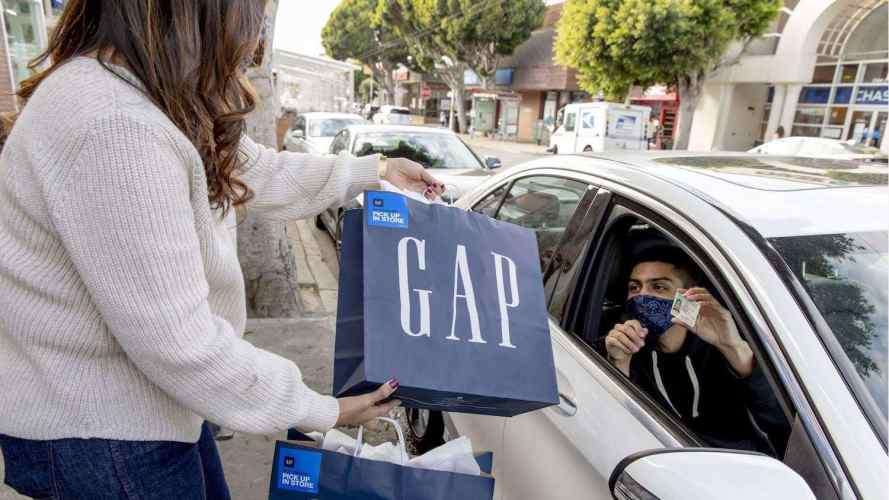Customer centricity has long been a brand priority to serve and engage customers. And for some, retail personalization is the engine of this mission. Case in point: Gap Inc. supported its customers with high-quality non-medical grade masks during the pandemic, and went on to launch and scale capabilities like curbside pickup and loyalty programs to make life easier for its customers. We spoke with John Strain, Gap Inc.’s chief digital and technology officer, who told us that while technology enables customer-centricity, people are at the core.
“A perfect example,” he said, “is that a great buy-online-pickup-in-store (BOPIS) or curbside pickup experience is as much about the processes and innovation from our store associates as it is about any technology.”
He explained that Gap Inc.’s strategy, store, management, and technology teams all worked together across its brands to scale and improve. This was especially important throughout 2020 and the COVID-19 crisis. One example: In November, Old Navy and Athleta rolled out in-store service hubs (Old Navy’s Convenience Spot and Athleta’s At Your Service) giving customers a way to bypass the checkout line for faster service.
Gap went one step further with a “doorbell” feature that allows curbside pickup customers to alert store associates without calling the store. All to provide convenience, speed, and safety for shoppers.
Want more retail leadership insights?
Find retail leaders’ strategy tips, plus technology and retail innovations. Get inspired by new ideas to create the best omni-channel experiences for your customers.



What started as a good deed became big business. Since April 2020, Gap has sold over $225 million worth of face masks to consumers and businesses. It credits masks with bringing more than one million new customers into its portfolio of brands.
The company redirected its manufacturing muscle to produce millions of non-medical grade masks for customers. It didn’t take long before Gap Inc. heard from other companies who wanted to supply their employees with the same masks. To provide this product, Gap Inc. used Salesforce Commerce Cloud Quick Start for B2B Commerce and partnered with digital transformation firm Capgemini to implement and service a custom website for masks in less than five weeks. Together they help manage purchase orders and deliver information about the program to businesses.
“We leveraged our deep supply chain relationships and agile operations to quickly come up with a solution that provides companies in both the private and public sectors with high-quality reusable, non-medical grade cloth face masks,” said Strain.
Gap Inc. elevates customer experience
Gap Inc.’s omni-channel capabilities and scaled operations led to customers spending 6% more with Gap brands in the third quarter of 2020 vs. 2019. It also saw a 50% year-over-year increase in net sales volume for BOPIS and curbside pickup orders, and a more than 60% increase in online net sales across all its brands.
“These results reflect the strength of our online business and our commitment to meeting the shopping preferences of our customers through our leading omni platform,” said Strain.
According to Strain, digital transformation, “is the way we leverage our integrated technical capabilities to deliver a better customer experience [which is] both omni-channel in nature and digitally-enhanced.”
Gap Inc.’s people are constantly discovering opportunities to re-elevate the customer experience. Pilot tests with its Athleta brand is a great example of people-led digital transformation. “Experimenting with one-on-one virtual styling sessions gives our associates the power to deliver next-level retail personalization, services, and convenience to shoppers,” said Strain.
“While the technology enables virtual clienteling, removing some constraints, the technology provides an opportunity for our store associates to demonstrate their product, brand, and customer knowledge in a new way,” Strain said.
Gap Inc. uses data and retail personalization to turn customers into brand loyalists
Most brands have some sort of loyalty program. The trick is using technology to manage customer data and loyalty to reward your customers and personalize interactions. To that end, one of Gap Inc.’s top company priorities this year is to convert more of its customers to be cross-brand and channel loyalists, Strain said.
In September 2020, Gap Inc. refreshed its membership programs that allow shoppers to earn and redeem rewards across its family of brands, with Navyist Rewards, Gap Good Rewards, Banana Republic Rewards, and Athleta Rewards.
“Although each brand expression has a different look and feel, customers can earn and redeem rewards. Think of it as one membership for all four brands,” said Strain. “The reason this is so important is that the more we can know our customers, the better we can support, engage, and reward them.”
They’re already off to a great start, enrolling more than 3.5 million new loyalty members (and counting) in the first two months. As it adds more customers to its program, the company uses that data to transition customers from a one-and-done transaction to a long-term cross-brand and multichannel customer. To get there, it’s undergoing a customer segmentation exercise that has yielded a dozen potential target segments across the entire U.S. apparel spectrum.
It gets more granular, applying data science to its existing customer file for the last two years to look at demographics, psychographics, and geographic insight to better target and serve customers, and select two or three target segments for each brand.
“We are continuing to use this segmentation data to help us drive relevant engagement with our customers through targeted marketing: personalizing emails, onsite experiences based on channel preference, loyalty status, and product affinity. And we are leveraging these segments to help drive the product lifecycle.”
Retail personalization at scale, he said, is a major focus for Gap Inc., and “the new currency for customer relevance in 2021.”
As our conversation came to a close, we asked Strain to describe retail in just one word. “Audacious,” he replied.“As a global retailer, we like to lean into our risk-taking history by seizing opportunities to create an incredible experience for our customers,” he said. “To lead the pack, you have to continuously grab customers’ attention in a meaningful way and offer them a more convenient and personalized experience. Sometimes this means pushing past boundaries and inspiring teams to create with audacity. Always go for the bold idea you’re passionate about and dedicate time to make it a successful one.”
Putting the customer first has never been more important
Gap Inc. gives customers what they need, when they need it. Want to learn more?































